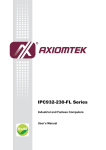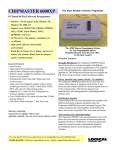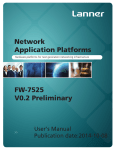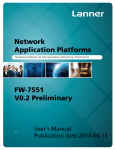Download IPC912 Series Industrial & Fanless Computers User`s
Transcript
IPC912 Series Industrial & Fanless Computers User’s Manual IPC912 Series User’s Manual Disclaimers This manual has been carefully checked and believed to contain accurate information. Axiomtek Co., Ltd. assumes no responsibility for any infringements of patents or any third party’s rights, and any liability arising from such use. Axiomtek does not warrant or assume any legal liability or responsibility for the accuracy, completeness or usefulness of any information in this document. Axiomtek does not make any commitment to update the information in this manual. Axiomtek reserves the right to change or revise this document and/or product at any time without notice. No part of this document may be reproduced, stored in a retrieval system, or transmitted, in any form or by any means, electronic, mechanical, photocopying, recording, or otherwise, without the prior written permission of Axiomtek Co., Ltd. ©Copyright 2011 Axiomtek Co., Ltd. All Rights Reserved Oct. 2011, Version A2 Printed in Taiwan ii IPC912 Series User’s Manual Safety Precautions Before getting started, please read the following important safety precautions. 1. The IPC912 Series does not come equipped with an operating system. An operating system must be loaded first before installing any software into the computer. 2. Be sure to ground yourself to prevent static charge when installing the internal components. Use a grounding wrist strap and place all electronic components in any staticshielded devices. Most electronic components are sensitive to static electrical charge. 3. Disconnect the power cord from the IPC912 Series before making any installation. Be sure both the system and the external devices are turned OFF. Sudden surge of power could ruin sensitive components. Make sure the IPC912 Series is properly grounded. 4. Make sure the voltage of the power source is correct before connecting the equipment to the power outlet. 5. Turn OFF the system power before cleaning. Clean the system using a cloth only. Do not spray any liquid cleaner directly onto the screen. 6. Do not leave this equipment in an uncontrolled environment where the storage temperature is below -20℃ or above 80℃. It may damage the equipment. 7. Do not open the system’s back cover. If opening the cover for maintenance is a must, only a trained technician is allowed to do so. Integrated circuits on computer boards are sensitive to static electricity. To avoid damaging chips from electrostatic discharge, observe the following precautions: Before handling a board or integrated circuit, touch an unpainted portion of the system unit chassis for a few seconds. This will help to discharge any static electricity on your body. When handling boards and components, wear a wristgrounding strap, available from most electronic component stores. iii IPC912 Series User’s Manual Classification 1. 2. 3. 4. 5. Degree of production against electric shock: not classified Degree of protection against the ingress of water: IPX0 Equipment not suitable for use in the presence of a flammable anesthetic mixture with air or with oxygen or nitrous oxide. Mode of operation: Continuous Type of protection against electric shock: Class I equipment General Cleaning Tips You may need the following precautions before you begin to clean the computer. When you clean any single part or component for the computer, please read and understand the details below fully. When you need to clean the device, please rub it with a piece of dry cloth. 1. Be cautious of the tiny removable components when you use a vacuum cleaner to absorb the dirt on the floor. 2. Turn the system off before you start to clean up the component or computer. 3. Never drop the components inside the computer or get circuit board damp or wet. 4. Be cautious of all kinds of cleaning solvents or chemicals when you use it for the sake of cleaning. Some individuals may be allergic to the ingredients. 5. Try not to put any food, drink or cigarette around the computer. Cleaning Tools: Although many companies have created products to help improve the process of cleaning your computer and peripherals users can also use household items to clean their computers and peripherals. Below is a listing of items you may need or want to use while cleaning your computer or computer peripherals. Keep in mind that some components in your computer may only be able to be cleaned using a product designed for cleaning that component, if this is the case it will be mentioned in the cleaning. iv IPC912 Series User’s Manual z z z z z Cloth: A piece of cloth is the best tool to use when rubbing up a component. Although paper towels or tissues can be used on most hardware as well, we still recommend you to rub it with a piece of cloth. Water or rubbing alcohol: You may moisten a piece of cloth a bit with some water or rubbing alcohol and rub it on the computer. Unknown solvents may be harmful to the plastics parts. Vacuum cleaner: Absorb the dust, dirt, hair, cigarette particles, and other particles out of a computer can be one of the best methods of cleaning a computer. Over time these items can restrict the airflow in a computer and cause circuitry to corrode. Cotton swabs: Cotton swaps moistened with rubbing alcohol or water are excellent tools for wiping hard to reach areas in your keyboard, mouse, and other locations. Foam swabs: Whenever possible it is better to use lint free swabs such as foam swabs. Note It is strongly recommended that you should shut down the system before you start to clean any single components. Please follow the steps below: 1. Close all application programs 2. Close operating software 3. Turn off power switch 4. Remove all device 5. Pull out power cable v IPC912 Series User’s Manual Scrap Computer Recycling If the computer equipments need the maintenance or are beyond repair, we strongly recommended that you should inform your Axiomtek distributor as soon as possible for the suitable solution. For the computers that are no longer useful or no longer working well, please contact your Axiomtek distributor for recycling and we will make the proper arrangement. Trademarks Acknowledgments Axiomtek is a trademark of Axiomtek Co., Ltd. IBM, PC/AT, PS/2, VGA are trademarks of International Business Machines Corporation. ® ® Intel and Pentium are registered trademarks of Intel Corporation. MS-DOS, Microsoft C and QuickBASIC are trademarks of Microsoft Corporation. SST is a trademark of Silicon Storage Technology, Inc. Other brand names and trademarks are the properties and registered brands of their respective owners. vi IPC912 Series User’s Manual Table of Contents Disclaimers........................................................................ ii Safety Precautions .......................................................... iii Classification ................................................................... iv General Cleaning Tips..................................................... iv Scrap Computer Recycling............................................. vi CHAPTER 1............................................................................ 1 INTRODUCTION ................................................................ 1 1.1 1.2 1.2.1 1.2.2 1.2.3 1.3 1.4 1.5 1.6 General Description.......................................... 2 System Specifications...................................... 3 Main CPU Board........................................................ 3 I/O System ................................................................ 3 System Specification............................................... 4 Dimensions ....................................................... 5 I/O Outlets.......................................................... 6 Jumper Settings................................................ 7 Packing List..................................................... 12 CHAPTER 2.......................................................................... 13 HARDWARE INSTALLATION ...................................... 13 2.1 2.2 2.3 2.4 Installing the Processor ................................. 13 Installing the Memory Module ....................... 17 Installing the Hard Disk Drive........................ 19 Installing the PCI or PCIe Card...................... 21 CHAPTER 3.......................................................................... 23 AMI BIOS UTILITY ........................................................... 23 3.1 3.2 3.3 3.4 3.5 Starting ............................................................ 23 Navigation Keys.............................................. 23 The Main Menu................................................ 24 Advanced BIOS Features............................... 25 PCI PnP Menu ................................................. 43 vii IPC912 Series User’s Manual 3.6 3.7 3.8 Boot Menu ....................................................... 45 Security Menu ................................................. 48 EXIT Menu ....................................................... 54 Appendix A .......................................................................... 56 CAN BUS Module Introduce............................................ 56 viii IPC912 Series User’s Manual MEMO ix IPC912 Series User’s Manual CHAPTER 1 INTRODUCTION This chapter contains general information and a detailed specification of the IPC912 Series. Chapter 1 includes the following sections: General Description System Specification Dimensions I/O Outlets Package List Introduction 1 IPC912 Series User’s Manual 1.1 General Description The IPC912 Series is a fanless system that can support Socket P for ® TM Intel Core ® 2 Duo/Celeron M processors. The IPC912 Series ® ® supports Windows XP, and Windows XP embedded, Vista, and Fedora, suitable for the most endurable operation. Reliable and Stable Design The IPC912 Series adopts two anti-vibration hard-drive bays, which makes it especially suitable for vibration environments, best for industrial automation, digital signage and gaming application. ¾ Embedded O.S. Supported The IPC912 Series not only supports Windows ® XP, but also ® supports embedded OS, such as Windows XP embedded. For storage device, the IPC912 Series supports one 2.5" HDD driver bay and one onboard CompactFlash ™ socket. 2 Introduction IPC912 Series User’s Manual 1.2 System Specifications 1.2.1 z Main CPU Board CPU ® TM ® z Socket P Intel Core 2 Duo/Celeron M processors System Chipset ® Intel GM45+ICH9M chipset BIOS z AMI BIOS, with Smart View and Customer CMOS Backup. System Memory z Two 204-pin DDR3 800/1066 MHz SODIMM sockets, with maximum up to 8GB Features Fanless Operation Compact & Front IO design Supports Two expansion slots DC to DC power supply support 10V to 30V z 1.2.2 z I/O System Standard I/O Interface -- Front ATX power on/off switch One 2-pin connector output for remote power on/off switch 10VDC to 30VDC with phoenix power plug or External 150W AC Adapter Six USB 2.0 ports HDD access/Power LEDs Three RS232(COM 2/3/4) One RS232/422/485(COM 1) One VGA connector Two 10/100 LAN ports Introduction 3 IPC912 Series User’s Manual z Expansion Slot HAB100: One PCIex1 & 1 PCIex4 or 2 PCIex1 HAB103: One PCI & One PCIex4 HAB102: One PCIex4 & One PCI-X NOTE The maximum power rating for expansion slots at 45℃can not be exceeded the following values +5V+5Vsb+3.3V<34W +5V+3.3V+12V<48W 1.2.3 z System Specification Drive Capacity z Supports One 2.5” HDD driver bay; one onboard CompactFlash™ Socket Power Input 10VDC to 30VDC with phoenix power plug External 150W AC Adapter – Power Input : 100VAC to 240VAC – Power Output : [email protected] z Operation Temperature z Storage Temperature z -20℃ ~ 80℃ Humidity z Ambient with air flow: 0℃ ~ 45℃ 10% ~ 90% (Non-condensing) Dimensions 142mm (5.6”) (W) x 248 mm (9.7”) (D) x 185mm (7.3”) (H) NOTE 4 All specifications and images are subject to change without notice. Introduction IPC912 Series User’s Manual 1.3 Dimensions The following diagrams show you dimensions and outlines of the IPC912 Series. Introduction 5 IPC912 Series User’s Manual 1.4 I/O Outlets The following figures show you I/O outlets on front and rear panels of the IPC912 Series. Front Panel 1. 2. 3. 4. 5. 6. 7. 8. 9. 6 Ethernet x 2 VGA Port USB 2.0 x 2 LED for Power & HDD ATX Power Switch Power Connector (Din Jack or Phoenix Plug) RS-232(COM2/3/4) RS-232/422/485(COM1) (Optional: user can use COM2 as a CAN BUS Module) Remote power switch USB 2.0 x 4 Introduction IPC912 Series User’s Manual 1.5 Jumper Settings The IPC912 has a number of jumpers inside the chassis that allow you to configure your system to suit your application. The table below lists the functions of the various jumpers. These jumpers select the COM1 port’s communication mode to operate RS-232 or RS-422/485. Description Function COM1 Introduction Jumper Setting RS-232 (Default) JP1 JP2 JP3 RS-422 JP1 JP2 JP3 RS-485 JP1 JP2 JP3 7 IPC912 Series User’s Manual These jumpers select the COM1, COM2 ports’ DCD and RI mode. Description COM1 DCD & RI Voltage Selection (JP6) Function Jumper Setting Pin 1=12V Pin 1=5V *Pin 1=DCD (Default) Pin 8=12V Pin 8=5V *Pin 8=RI (Default) 8 Introduction IPC912 Series User’s Manual Description COM2 DCD & RI Voltage Selection (JP5) Function Jumper Setting Pin 1=12V Pin 1=5V *Pin 1=DCD (Default) Pin 8=12V Pin 8=5V *Pin 8=RI (Default) NOTE: If you are using COM2 as a CAN Bus module, please refer to Appedix A. Introduction 9 IPC912 Series User’s Manual CompactFlash™ Device Setting Jumper (JP8~11) Jumper CF Device Description Jumper Setting Enable (Default) Description Jumper Setting Disable ComplactFlash™ Voltage Selection Jumper (JP12) This jumper is to select the voltage for CompactFlashTM interface. Description Function Jumper Setting TM 3.3V (Default) CompactFlash Voltage Selection 5V CMOS Clear Jumper (JP19) You may need to use this jumper to clear the CMOS memory if incorrect settings in the Setup Utility. Description CMOS Clear Function Jumper Setting Normal (Default) Clear CMOS 10 Introduction IPC912 Series User’s Manual USB Voltage Selection Jumpers (JP14, JP15, JP17) This jumper is to select the voltage for USB interface. Description USB Voltage Selection Function Jumper Setting 5V 5V_SBY LVDS Voltage Selection Jumper (JP18) This jumper is to select the voltage for LVDS interface. Description LVDS Voltage Selection Function Jumper Setting 3.3V (Default) 5V Introduction 11 IPC912 Series User’s Manual 1.6 Packing List The package bundled with your IPC912 Series should contain the following items: z z z z z z z z IPC912 Series Unit x 1 19V 150W Adapter and US Power Cord (for IPC912 AC Version) Driver CD Quick Manual Wall Mount Bracket x 2 HD Bracket x 1 Screw pack x 1 Food pad x 4 If you can not find this package or any items are missing, please contact Axiomtek distributors immediately. 12 Introduction IPC912 Series User’s Manual CHAPTER 2 HARDWARE INSTALLATION The IPC912 Series are convenient for your various hardware configurations, such as CPU (Central Processing Unit), Memory Module, HDD (Hard Disk Drive) and PCIe card. The chapter 2 will show you how to install the hardware. It includes: 2.1 Installing the Processor ® ® The Intel Pentium M Processor is available as a boxed processor for laptop computers in the micro-FCPGA form factor. Intel recommends the processor should be installed by a computer professional since this electronic device may cause serious damage to the installer, system and processor if installed improperly. Important Notes Before attempting to install a new processor, carefully review the documentation that came with your system and make sure that you will not be voiding your warranty by opening the computer or replacing your processor. Instructions: ® 1. Make sure that your system can accommodate the Intel ® Pentium M Processor that you want to install. Check for motherboard, BIOS, and thermal compatibility by using the manufacturer's documentation for the laptop computer, or by contacting the vendor if necessary. This processor should only ® ® be installed in systems supporting the Intel Pentium M Processor. ® 2. ® Important Notes Do not use an Intel Pentium M Processor in a desktop system and do not use a desktop processor in an ® ® Intel Pentium M Processor notebook. Since these processors have different electrical specifications, damage to the processor and system can occur. Obtain access to your processor socket as described in the documentation for your system. Hardware Installation 13 IPC912 Series User’s Manual 3. If the cooling solution prevents you from accessing the processor socket, you may need to remove it. Instructions on how to remove your cooling solution should be provided in the documentation that came with the system. 4. To un-install the current processor, use a screwdriver to disengage (open) the socket actuator, as shown in Figure 1 below. (The most commonly used sockets are Molex* or FoxConn* sockets, so they are used in the illustrations below.) The socket actuator should open after only a half turn or so, and you should then be able to remove the processor with your fingers. Procedure of Installation: Step 1 Turn off the system. Step 2 Disconnect the power connector. Step 3 Loosen screws to remove the top and side covers from the chassis. 14 Hardware Installation IPC912 Series User’s Manual Step 4 After opening the top and side covers, you can locate the CPU socket and heatsink as marked. Align pins of the CPU with pin holes of the socket. Be careful of the CPU’s orientation that you need to align the arrow mark on the CPU with the arrow key on the socket. Place the CPU into the socket, and use a screwdriver to lock it onto the socket. Step 5 Place the CPU Heatsink on the CPU, and lock it by screwdriver. Hardware Installation 15 IPC912 Series User’s Manual Step 6 Close the top and side covers back to the chassis, and fasten all screws. 16 Hardware Installation IPC912 Series User’s Manual 2.2 Installing the Memory Module Step 1 Turn off the system. Step 2 Disconnect the power connector. Step 3 Loosen screws to remove the side cover from the chassis. Step 4 Please follow steps below to install the upper memory module: 1. Align the memory module with the socket that notches of memory module must match the socket keys for a correct installation. Hardware Installation 17 IPC912 Series User’s Manual 2. Install the memory module into the socket and push it firmly down until it is fully seated. The socket latches are clipped on to the edges of the SO-DIMM. Step 5 18 Put back the side cover to the chassis and fasten all screws. Hardware Installation IPC912 Series User’s Manual 2.3 Installing the Hard Disk Drive The IPC912 Series offers a convenient drive bay module for users to install HDD. The system offers users one 2.5” Hard Disk Drive for installation. Please follow the steps: Step 1 Turn off the system. Step 2 Disconnect the power connector. Step 3 Loosen screws to remove the top & Side cover from the chassis. Step 4 Open the top cover and locate the two Hard Disk Drives from the side. Hardware Installation 19 IPC912 Series User’s Manual Step 5 Use assembly parts to fix HDD with the bracket. Step 6 Install and fix the HDD through the side, next, plug the power cable in HDD. Step 7 Close the top cover back to the chassis and fasten all screws. 20 Hardware Installation IPC912 Series User’s Manual 2.4 Installing the PCI or PCIe Card Step 1 Turn off the system. Step 2 Disconnect the power connector. Step 3 Loosen screws to remove the top cover from the chassis. Removing the PCI or PCIe bracket by releasing the button as marked. Step 4 Locate the PCI or PCIe slots from the side. Hardware Installation 21 IPC912 Series User’s Manual Step 5 Align the PCI or PCIe card with the slot, and press the card into the slot until it is firmly seated. Step 6 22 Close the top cover back to the chassis and fasten all screws. Hardware Installation IPC912 Series User’s Manual CHAPTER 3 AMI BIOS UTILITY This chapter provides users with detailed description how to set up basic system configuration through the AMIBIOS8 BIOS setup utility. 3.1 Starting To enter the setup screens, follow the steps below: 1. Turn on the computer and press the <Del> key immediately. After you press the <Delete> key, the main BIOS setup menu displays. You can access the other setup screens from the main BIOS setup menu, such as the Chipset and Power menus. 3.2 Navigation Keys ÆÅ Left/Right The Left and Right <Arrow> keys allow you to select a setup screen. ÇÈ Up/Down The Up and Down <Arrow> keys allow you to select a +− Plus/Minus Tab F1 setup screen or sub-screen. The Plus and Minus <Arrow> keys allow you to change the field value of a particular setup item. The <Tab> key allows you to select setup fields. The <F1> key allows you to display the General Help screen. The <F10> key allows you to save any changes you have F10 Esc made and exit Setup. Press the <F10> key to save your changes. The <Esc> key allows you to discard any changes you have made and exit the Setup. Press the <Esc> key to exit the setup without saving your changes. Enter The <Enter> key allows you to display or change the setup option listed for a particular setup item. The <Enter> key can also allow you to display the setup sub- screens. AMI BIOS Utility 23 IPC912 Series User’s Manual 3.3 The Main Menu Once you enter the AMI BIOS CMOS Setup Utility, the Main Menu appears on the screen. In the Main Menu, there are several Setup functions and a couple of Exit options for your selection. Use arrow keys to select the Setup Page you intend to configure then press <Enter> to accept or enter its sub-menu. z System Time/Date Use this option to change the system time and date. Highlight System Time or System Date using the <Arrow> keys. Enter new values through the keyboard. Press the <Tab> key or the <Arrow> keys to move between fields. The date must be entered in MM/DD/YY format. The time is entered in HH:MM:SS format. 24 Utility AMI BIOS IPC912 Series User’s Manual 3.4 Advanced BIOS Features The Advanced menu allows users to set configuration of the CPU and other system devices. You can select any of the items in the left frame of the screen to go to the sub menus: y y y y y y y y y y y y CPU Configuration IDE Configuration Floppy Configuration SuperIO Configuration Hardware Health Configuration ACPI Configuration AHCI Configuration APM Configuration Event Log Configuration Intel VT-d Configuration Smbios Configuration USB Configuration For items marked with “f”, please press <Enter> for more options. AMI BIOS Utility 25 IPC912 Series User’s Manual z CPU Configuration This screen shows the CPU Configuration, and you can change the value of the selected option this section allows you to configure and improve your system, to set up some system features according to your preference. 26 Utility AMI BIOS IPC912 Series User’s Manual z CPU Feature Scroll to this item and press <Enter> to view the CPU Feature sub menu. ¾ MPS Revision Use this item to select MPS (Multi Processor Specification) Revision 1.1 or 1.4. The default setting is 1.4. ¾ Hardware Prefetcher This item automatically analyzes its requirements and prefetches data and instructions from the memory. When enabled, the processor’s hardware prefetcher will be allowed to automatically prefetch data and code for the processor. AMI BIOS Utility 27 IPC912 Series User’s Manual ¾ Adjacent Cache Line Prefetch This item has a hardware adjacent cache line prefetch mechanism that automatically fetches extra cache line whenever the processor requests for a cache line. This reduces cache latency by making the next cache line immediately available if the processor requires it as well. The processor will retrieve the currently requested cache line and the subsequent cache line when enabled. The processor will only retrieve the currently requested cache line when disabled. ¾ Max CPUID Value Limit You can enable this item to let legacy operating systems boot even without support for CPUs with extended CPU ID functions. ¾ Intel (R) Virtualization Tech Use this feature to enable or disable the Intel Virtualization Technology (IVT) extensions, which allow multiple operating systems to run simultaneously on the same system. When the IVT extensions are enabled, it allows for hardware-assisted virtual machine management. ¾ Execute-Disable Bit Capability This item helps you enable or disable the No-Execution Page Protection Technology. ¾ Core Multi-Processing This feature controls the functionality of the Core MultiProcessing to allow the processor to execute multitasking function. ¾ Intel (R) SpeedStep (tm) tech This item helps you enable or disable the Intel SpeedStep Technology. ¾ Intel (R) C-STATE tech Use this item to enable or disable the C-State technology. 28 Utility AMI BIOS IPC912 Series User’s Manual z IDE Configuration You can use this screen to select options for the IDE Configuration, and change the value of the selected option. A description of the selected item appears on the right side of the screen. For items marked with “f”, please press <Enter> for more options. ¾ SATA#1 Configuration Use this item to control the onboard SATA controller. Here are the options for your selection, Compatible, Disabled, and Enhanced. ¾ Configure SATA#1 as Use this item to choose the SATA operation mode. Here are the options for your selection, IDE and AHCI. ¾ SATA#2 Configuration Use this item to control the onboard SATA controller. Here are the options for your selection, Enhanced and Disabled. ¾ Primary/Secondary/Third/Fourth IDE Master/Slave Select one of the hard disk drives to configure IDE devices installed in the system by pressing <Enter> for more options. AMI BIOS Utility 29 IPC912 Series User’s Manual z Floppy Configuration You can use this screen to select options for the Floppy Configuration, and change the value of the selected option. A description of the selected item appears on the right side of the screen. For items marked with “f”, please press <Enter> for more options. ¾ 30 Utility Floppy A This item selects the type of floppy disk installed in the computer. AMI BIOS IPC912 Series User’s Manual z SuperIO Configuration You can use this screen to select options for the SuperIO Configuration, and change the value of the selected option. A description of the selected item appears on the right side of the screen. ¾ OnBoard Floppy Controller Use this item to enable or disable the onboard floppy drive controller. ¾ Serial Port1 Address This option specifies the base I/O port address and Interrupt Request address of serial port 1. The Optimal setting is 3F8/IRQ4. The Fail-Safe default setting is Disabled. ¾ Serial Port2 Address This option specifies the base I/O port address and Interrupt Request address of serial port 2. The Optimal setting is 2F8/IRQ3. The Fail-Safe setting is Disabled. AMI BIOS Utility 31 IPC912 Series User’s Manual 32 Utility ¾ Serial Port2 Mode This item specifies the mode used by the serial port 2. ¾ Parallel Port Address Select an operating mode for the onboard parallel (printer) port. ¾ Parallel Port IRQ Use this item to set up the IRQ for onboard parallel port. AMI BIOS IPC912 Series User’s Manual z Hardware Health Configuration This screen shows the Hardware Health Configuration, and a description of the selected item appears on the right side of the screen ¾ H/W Health Function You can select this item Enabled for the Hardware Health Monitoring Device. The Hardware Health Event Monitoring displays the temperature of CPU and System, Fan Speed, Vcore, etc. ¾ SYSFAN/CPUFAN/AUXFAN Mode Setting These items can enable or disable the Smart Fan to adjust the CPU/system fan speed automatically in accordance with the current CPU temperature that can prevent the system overheating. There are these options Manual Mode and Thermal Cruise Mode. AMI BIOS Utility 33 IPC912 Series User’s Manual z ACPI Configuration You can use this screen to select options for the ACPI Configuration, and change the value of the selected option. A description of the selected item appears on the right side of the screen. 34 Utility ¾ General ACPI Configuration Scroll to this item and press <Enter> to view the General ACPI Configuration sub menu, which contains General ACPI (Advanced Configuration and Power Management Interface) options for your configuration. ¾ Advanced ACPI Configuration Scroll to this item and press <Enter> to view the Advanced ACPI Configuration sub menu, which contains Advanced ACPI (Advanced Configuration and Power Management Interface) options for your configuration. ¾ Chipset ACPI Configuration Scroll to this item and press <Enter> to view the Chipset ACPI Configuration sub menu, which contains Chipset ACPI (Advanced Configuration and Power Management AMI BIOS IPC912 Series User’s Manual Interface) options for your configuration. AMI BIOS Utility 35 IPC912 Series User’s Manual z AHCI Configuration You can use this screen to select options for the AHCI Configuration, and change the value of the selected option. A description of the selected item appears on the right side of the screen. ¾ 36 Utility AHCI BIOS Support You can enable or disable this item to control the AHCI function of the SATA controller. AMI BIOS IPC912 Series User’s Manual z APM Configuration You can use this screen to select options for the APM Configuration, and change the value of the selected option. A description of the selected item appears on the right side of the screen. ¾ Power Management Set this value to allow Power Management/APM support. The default setting is Enabled. Disabled Set this value to prevent the chipset power management and APM (Advanced Power Management) features. Enabled Set this value to allow the chipset power management and APM (Advanced Power Management) features. This is the default setting. AMI BIOS Utility 37 IPC912 Series User’s Manual ¾ Power Button Mode This option specifies how the externally mounted power button on the front of the computer chassis is used. The default setting is On/Off. On/Off Pushing the power button turns the computer on or off. This is the default setting. This is the default setting. Standby Pushing the power button places the computer in Standby mode. Suspend Pushing the power button places the computer in Suspend mode or Full On power mode. ¾ Video Power Down Mode This option specifies the Power State that the video subsystem enters when the BIOS places it in a power saving state after the specified period of display inactivity has expired. The default setting is Suspend. Disabled Standby Suspend ¾ 38 Utility This setting prevents the BIOS from initiating any power saving modes concerned with the video display or monitor. This option places the monitor into standby mode after the specified period of display inactivity has expired. This means the monitor is not off. The screen will appear blacked out. The standards do not cite specific power ratings because they vary from monitor to monitor. This option places the monitor into suspend mode after the specified period of display inactivity has expired. This means the monitor is not off. The screen will appear blacked out. The standards do not cite specific power ratings because they vary from monitor to monitor, but this setting use less power than Standby mode. This is the default setting. Hard Disk Drive Power Down Mode This option specifies the power conserving state that the hard disk drive enters after the specified period of hard drive inactivity has expired. The default setting is Suspend. AMI BIOS IPC912 Series User’s Manual Disabled This setting prevents hard disk drive power down mode. Standby This option stops the hard disk drives from spinning during a system standby. Suspend This option cuts the power to the hard disk drives during a system suspend. This is the default setting. ¾ Throttle Slow Clock Ratio Use this item to specify the speed of the system clock when running the power saving states. ¾ System Thermal Use this item to enable or disable the function of system temperature control. ¾ Resume On Ring This item enables or disables the function of Resume on Ring that resume the system through incoming calls. ¾ Resume On RTC Alarm You can set “Resume On RTC Alarm” item to enabled and key in Data/time to power on system. AMI BIOS Utility 39 IPC912 Series User’s Manual z Event Log Configuration This screen shows the Event Log Configuration, and a description of the selected item appears on the right side of the screen. ¾ View Event Log This item is to display the system events in the System Event Log. ¾ Mark all events as read This item is to mark all events in the log as read. ¾ 40 Utility Clear Event Log Enable this item is to clear the event log each time the system is rebooted. AMI BIOS IPC912 Series User’s Manual z Smbios Configuration You can use this screen to select options for the Smbios Configuration, and change the value of the selected option. A description of the selected item appears on the right side of the screen. ¾ Smbios Smi Support When this item is enabled, the system can support the SMBIOS SMI wrapper for the PnP. AMI BIOS Utility 41 IPC912 Series User’s Manual z USB Configuration You can use this screen to select options for the USB Configuration, and change the value of the selected option. A description of the selected item appears on the right side of the screen. ¾ USB Functions This item allows you to enable or disable USB functions. ¾ Legacu USB Support Use this item to enable or disable support for USB device on legacy operating system. The default setting is Enabled 42 Utility AMI BIOS IPC912 Series User’s Manual 3.5 PCI PnP Menu The PCI PnP menu allows users to change the advanced settings for PCI/PnP devices. ¾ Clear NVRAM Use this item to clear the data in the NVRAM (CMOS). Here are the options for your selection, No and Yes. ¾ Plug & Play O/S When the setting is No, Use this item to configure all the devices in the system. When the setting is Yes and if you install a Plug and Play operating system, the operating system configures the Plug and Play devices not required for boot. The default setting is No. ¾ PCI Latency Timer This item controls how long a PCI device can hold the PCI bus before another takes over. The longer the latency, the longer the PCI device can retain control of the bus before handing it over to another PCI device. There are several options for your selection. AMI BIOS Utility 43 IPC912 Series User’s Manual ¾ Allocate IRQ to PCI VGA This item allows BIOS to choose an IRQ to assign for the PCI VGA card. Here are the options for your selection, No and Yes. ¾ Palette Snooping Some old graphic controllers need to “snoop” on the VGA palette, and then map it to their display as a way to provide boot information and VGA compatibility. This item allows such snooping to take place. Here are the options for your selection, Disabled and Enabled. ¾ PCI IDE BusMaster This item is a toggle for the built-in driver that allows the onboard IDE controller to perform DMA (Direct Memory Access) transfer. Here are the options for your selection, Disabled and Enabled. ¾ OffBoard PCI/ISA IDE Card This item is for any other non-onboard PCI/ISA IDE controller adapter. There are several options for your selection. ¾ IRQ3/4/5/7/9/10/11/14/15 These items will allow you to assign each system interrupt a type, depending on the type of device using the interrupt. The option “Available” means the IRQ is going to assign automatically. Here are the options for your selection, Available and Reserved. ¾ DMA Channel 0/1/3/5/6/7 These items will allow you to assign each DMA channel a type, depending on the type of device using the channel. The option “Available” means the channel is going to assign automatically. Here are the options for your selection, Available and Reserved. 44 Utility AMI BIOS IPC912 Series User’s Manual 3.6 Boot Menu The Boot menu allows users to change boot options of the system. You can select any of the items in the left frame of the screen to go to the sub menus: y Boot Settings Configuration For items marked with “f”, please press <Enter> for more options. AMI BIOS Utility 45 IPC912 Series User’s Manual z Boot Settings Configuration 46 Utility ¾ Quick Boot Enabling this item lets the BIOS skip some power on self tests (POST). The default setting is Enabled. ¾ LAN1/LAN2 Boot Use these items to enable or disable the Boot ROM function of the onboard LAN chip when the system boots up. ¾ AddOn ROM Display Mode This item selects the display mode for option ROM. The default setting is Force BIOS. ¾ Boot Num-Lock Use this item to select the power-on state for the NumLock. The default setting is On. ¾ Wait For ‘F1’ Of Error If this item is enabled, the system waits for the F1 key to be pressed when error occurs. The default setting is Enabled. AMI BIOS IPC912 Series User’s Manual ¾ Hit ‘DEL’ Message Display If this item is enabled, the system displays the message “Press DEL to run Setup” during POST.The default setting is Enabled. ¾ Interrupt 19 Capture If this item is enabled, this function makes the option ROMs to trap Interrupt 19. The default setting is Disabled. AMI BIOS Utility 47 IPC912 Series User’s Manual 3.7 Security Menu The Security menu allows users to change the security settings for the system. 48 Utility ¾ Supervisor Password This item indicates whether a supervisor password has been set. If the password has been installed, Installed displays. If not, Not Installed displays. ¾ User Password This item indicates whether a user password has been set. If the password has been installed, Installed displays. If not, Not Installed displays. ¾ Change Supervisor Password Select this option and press <Enter> to access the sub menu. You can use the sub menu to change the supervisor password. AMI BIOS IPC912 Series User’s Manual ¾ Change User Password Select this option and press <Enter> to access the sub menu. You can use the sub menu to change the user password. ¾ Boot Sector Virus Protection This option is near the bottom of the Security Setup screen. The default setting is Disabled Disabled Enabled Set this value to prevent the Boot Sector Virus Protection. This is the default setting. Select Enabled to enable boot sector protection. It displays a warning when any program (or virus) issues a Disk Format command or attempts to write to the boot sector of the hard disk drive. If enabled, the following appears when a write is attempted to the boot sector. You may have to type N several times to prevent the boot sector write. Boot Sector Write! Possible VIRUS: Continue (Y/N)? _ The following appears after any attempt to format any cylinder, head, or sector of any hard disk drive via the BIOS INT 13 Hard disk drive Service: Format!!! Possible VIRUS: Continue (Y/N)? AMI BIOS Utility 49 IPC912 Series User’s Manual z Chipset Menu The Chipset menu allows users to change the advanced chipset settings. You can select any of the items in the left frame of the screen to go to the sub menus: y y North Bridge Configuration South Bridge Configuration For items marked with “f”, please press <Enter> for more options. 50 Utility AMI BIOS IPC912 Series User’s Manual z North Bridge Configuration ¾ Memory Hole You can reserve this area of system memory for ISA adapter ROM. When this area is reserved it cannot be cached. Check the user information of peripherals that need to use this area o f system memory for the memory requirements. Here are the options, Disabled and 15M-16M. ¾ Boot Graphic Adapter Priority This item allows you to select the graphics controller as the primary boot device. ¾ Internal Graphics Mode Select This item allows you to select the amout of system memory used by the internal graphics device. ¾ PEG Port Configuration/PEG Port This item is a toggle to enable or disable the PCI Express port. Here are the options for your selection, Auto and Disabled. AMI BIOS Utility 51 IPC912 Series User’s Manual Video Function Configuration You can press <Enter> for the sub-menu to set up video function. South Bridge Configuration ¾ z 52 Utility ¾ USB Controller This item allows you to enable or disable USB function/controller. ¾ Restore on AC Power Loss This item can control how the PC will behave once power is restored following a power outage, or other unexpected shutdown. ¾ PCIE Port Configuration This item can control how the PC will behave once power is restored following a power AMI BIOS IPC912 Series User’s Manual outage, or other unexpected shutdown. AMI BIOS Utility 53 IPC912 Series User’s Manual 3.8 EXIT Menu The Exit menu allows users to load your system configuration with optimal or failsafe default values. ¾ Save Changes and Exit When you have completed the system configuration changes, select this option to leave Setup and reboot the computer so the new system configuration parameters can take effect. Select Save Changes and Exit from the Exit menu and press <Enter>. Select Ok to save changes and exit. ¾ Discard Changes and Exit Select this option to quit Setup without making any permanent changes to the system configuration. Select Discard Changes and Exit from the Exit menu and press <Enter>. Select Ok to discard changes and exit. Discard Changes Use this item to abandon all changes. ¾ 54 Utility AMI BIOS IPC912 Series User’s Manual ¾ Load Optimal Defaults It automatically sets all Setup options to a complete set of default settings when you select this option. The Optimal settings are designed for maximum system performance, but may not work best for all computer applications. In particular, do not use the Optimal Setup options if your computer is experiencing system configuration problems. Select Load Optimal Defaults from the Exit menu and press <Enter>. ¾ Load Fail-Safe Defaults It automatically sets all Setup options to a complete set of default settings when you select this option. The Fail-Safe settings are designed for maximum system stability, but not maximum performance. Select the Fail-Safe Setup options if your computer is experiencing system configuration problems. Select Load Fail-Safe Defaults from the Exit menu and press <Enter>. Select Ok to load Fail-Safe defaults. AMI BIOS Utility 55 IPC912 Series User’s Manual Appendix A CAN BUS Module Introduce A.1 Board Layout 56 Can Bus Module Introduce IPC912 Series User’s Manual A.2 Block Diagram Can Bus Module Introduce 57 IPC912 Series User’s Manual A.3 Connector Pin Define COM1 PIN PIN Define 1 NC 2 CAN_L 3 CAN_GND 4 NC 5 NC 6 CAN_GND 7 CAN_H 8 NC 9 NC 58 Can Bus Module Introduce IPC912 Series User’s Manual CN2 PI N PIN Define(USB) PIN Define(RS23 2) PI N PIN Defin e 1 5V 5V 2 NC 3 USB_D- TXD 4 CTS 5 USB_D+ RXD 6 RTS 7 NC NC 8 NC 9 GND GND 10 GND Connection for CAN transmission NOTE: To be sure there is, at least one side of the MJP2 have short. (This is 120ohm termination resistors) Can Bus Module Introduce 59

















































































